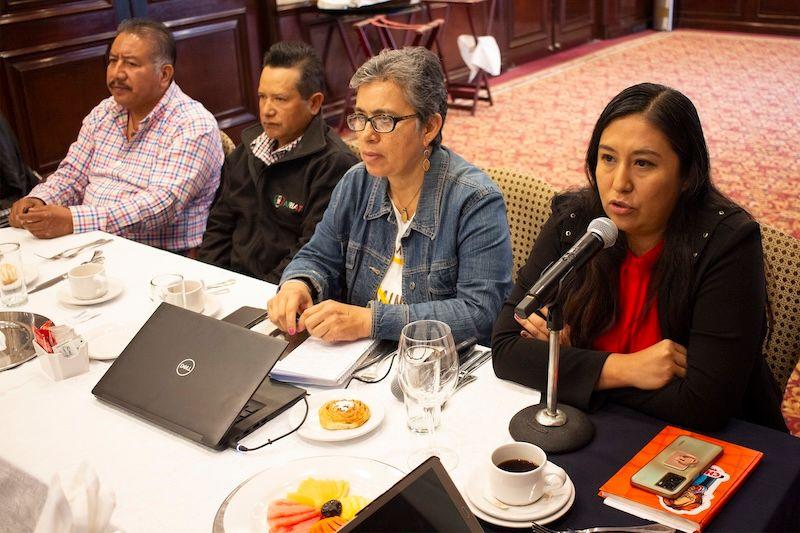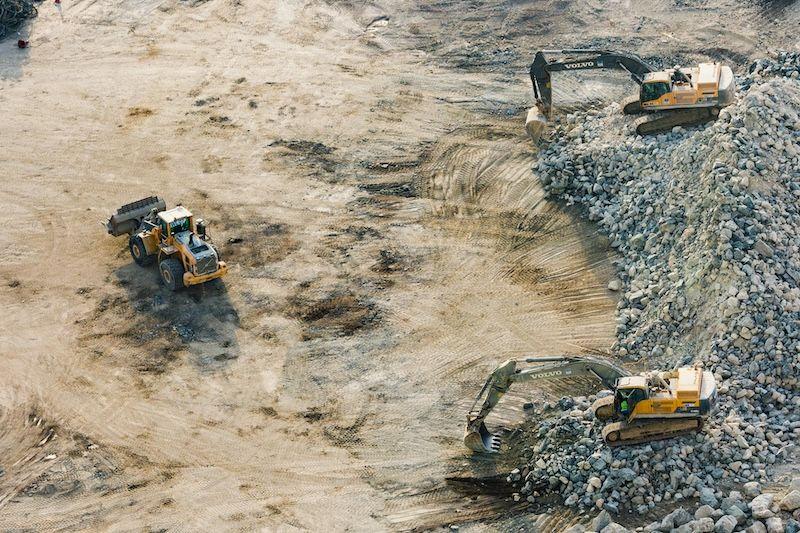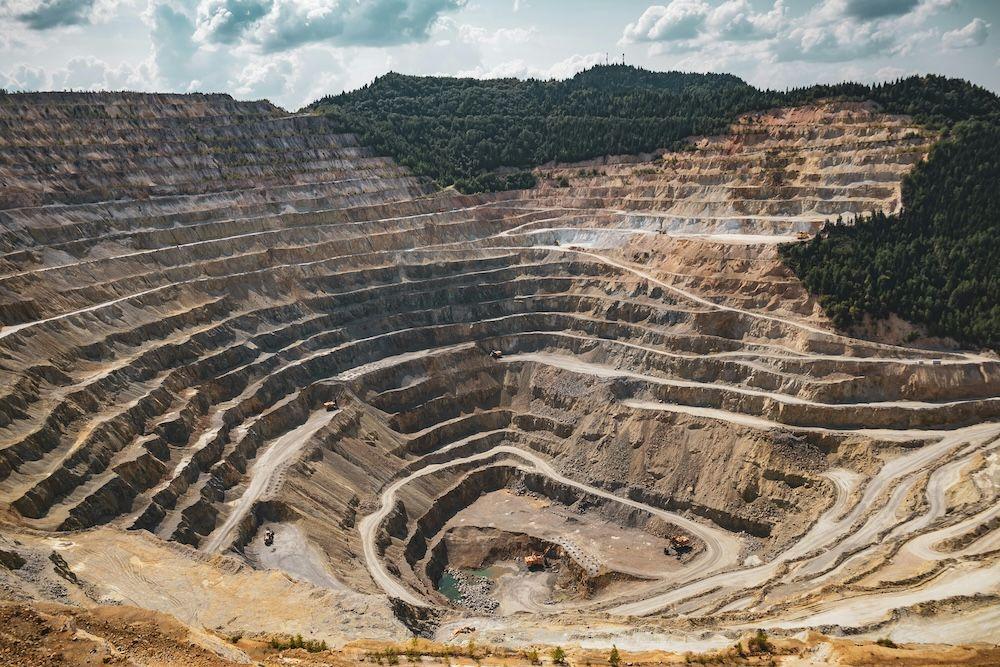“We don't agree that open-pit mining is still being implemented in our country,” says Felipe Pinedo, a resident of Mazapil, in Zacatecas, where the Peñasquito mine, owned by the American Newmont Corporation, has been mining gold since 2006.
Felipe traveled from Mazapil to Mexico City to participate in the press conference organized by Cambiémosla Ya, a collective of environmental defenders and academics who promote the prohibition of open pit mining.
Last August, the Committee on Constitutional Points of the Chamber of Deputies announced that the reform in this area will be discussed. It was presented by President Andrés Manuel López Obrador in February as part of a package of 20 constitutional reforms.
Also at the conference were Rogelio Varela, a resident of San Pedro Hill, in San Luis Potosí, where the San Xavier mining company operated for 15 years, and Martha Patricia Velarde, a resident of Cananea, Sonora, where the Buenavista del Cobre mine, owned by Grupo México, occurred in 2014.
Everyone agrees that the ban must be approved.
“Zacatecas is a state that grew up with mining, but it's a very aggressive mining,” said Felipe Pinedo, after listing a series of documented damages since the installation of the mine. Environmental devastation, water hoarding, underpaid jobs and the criminalization of those who oppose the activity are some of these.
Although the ban does not contemplate the closure of the open pit mines that are currently in operation, in recent weeks the Mining Chamber of Mexico (Camimex), which groups together and represents the interests of the mining industry, has expressed its opposition to the proposal.
“If approved in both Houses (Deputies and Senators), it will have devastating consequences for the development and economic stability of Mexico,” Camimex said in a statement on August 14.
Among the arguments about the consequences of passing the law, businessmen listed the loss of formal jobs, the impact on the development indices of more than 690 communities in the country and the economic contraction in the National Gross Domestic Product (GDP).
However, residents of these mining regions and academics verified this information and presented the counterpart of the figures.

Felipe Pinedo, resident of Mazapil; Rogelio Varela, resident of Cerro de San Pedro; Dolores Rojas, Program Coordinator of the Heinrich Böll Foundation; Beatriz Olivera, director of Engenera A.C. Photo: Let's Change It Now.
They call it development
In response to Camimex's statements about its contribution of 2.5% to 4.3% to the national GDP, Beatriz Olivera, director of Engenera A.C. and part of Cambiémosla Ya, said that it is important “not to inflate the numbers”.
“Mining GDP, as established by INEGI (National Institute of Statistics and Geography), is comprised of three activities. One of them is the mining of metallic and non-metallic metals, another is the extraction of oil and gas, and another one is related to services,” Olivera explained.
Metal mining is linked to open-pit mining and gold, silver and copper are extracted from it. According to Olivera, if only open-pit mining is considered in GDP estimates, the indicator's contribution percentage drops to 1.02%.
In addition to GDP, Camimex has insisted on the loss of more than 1 million formal jobs. They also shared that 60% of formal mining has been open-pit, generating 200,000 direct jobs and 1.5 million indirect jobs.
“Unfortunately, Camimex has never published the methodology to estimate this,” said Isidro Téllez, a researcher at the Institute of Geography of the National Autonomous University of Mexico (UNAM), during his participation in the press conference.
Téllez, together with other researchers from the Institute of Geography, has reviewed official sources such as the Mining Statistical Yearbooks of the Mexican Geological Survey and the Economic Censuses to evaluate the jobs generated by mining.
Some of the most important findings related to metal mining are that it has offered two out of every 100 jobs nationwide in the last two decades. In addition, Mexican mining workers receive a salary nine times lower than their peers in Canada and that the precious metals sector has the highest proportion of subcontracted workers (70%).
“Employment is an element for which many communities have accepted and could continue to accept this type of mining, so it is very important to understand that there are people who do not reject mining and accept it for employment. There are areas where there is no other form of work than this one. We must understand this peculiarity and, therefore, we must disaggregate the information we have about the variable: how many jobs it generates, what type they are, under what hiring mechanisms they are,” explained researcher Téllez.
Environmental facts
Faced with the proposed ban, Camimex has stated that it would be better to build a regulatory framework that reconciles this type of mining with the environment. However, open pit mining requires explosions all the way to the bedrock, which wipes out all the vegetation cover on the site.
In addition, during extraction, leach piles (removal of substances from a solid) sprayed by chemicals such as cyanide, lead, mercury, among others harmful to health, accumulate, and water is used for processing. The latter has been the most criticized because of the overexploitation and the pollution it generates.
“In the case of copper, 1,500 liters of water are used per ton. In its last report, Grupo México said that the Buenavista del Cobre mine produced 874,000 tons per year, which translates into 1,311 million of water from a single mine. This would be the supply of 35,000 people,” explained Carla Flores, a researcher at CartoCrítica, an organization dedicated to georeferenced socio-environmental information.
According to Flores, during open pit mining, dams form with all the toxic solutions that end up spilling into nearby bodies of water. “They are giant pools with this toxic waste, such as the Cananea one of up to 3,300 hectares that would be the entire Cuauhtémoc mayor's office in Mexico City,” said the researcher.
At the conference, Martha Patricia Velarde, a resident of Cananea, shared her testimony about life after the Buenavista del Cobre mine spill that occurred in the Sonora River 10 years ago.
“The pollution in Cananea is appalling. Imagine everything that mining uses, is breathed in by people. There is scientific evidence for health effects, especially cancer, because it is very common to see diseases in Cananea and the entire Sonora River basin. Much more in these 11 years without a toxic waste management plan,” said Velarde.

Countries such as Turkey, Germany, Australia and Costa Rica have banned open-pit mining. Photo: Pexels.
Although discussions about open pit mining have not yet passed the Chamber of Deputies, Mexico could join countries such as Turkey, Germany, Australia, Costa Rica and several U.S. states that have banned this practice.
For her part, President-elect Claudia Sheinbaum shared her 100 government commitments since March . Number 87 indicates that “no more open-pit mining concessions will be granted. Those that have concessions will be evaluated as long as there is recognition from the population and they have no environmental impacts.”
For the communities of Zacatecas, Sonora and San Luis Potosí, who have experienced the impacts of open-pit mining for decades, this represents a step forward. However, they point out that more is required to achieve significant changes.
“It's up to communities to continue resisting, to keep fighting, because we are the ones who are suffering from pollution on a daily basis, those who suffer without water, and those who criminalize us and throw us away at the police and organized crime so that we don't continue protesting,” said Felipe Pinedo.
The defender proposes that in addition to the Mining Law, the National Water Law and the Agrarian Law be revised, which have also allowed extractive activities to continue.
“Not only are we seeking remedy, in addition to justice, we are asking for guarantees of non-repetition. But with the latent threats, we see it as remote and I think that's one of the reasons for not setting precedents about remedying communities that suffer the abuses of these mining companies,” added Martha Patricia Velarde.



Comentarios (0)